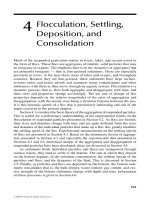Chapter 4: SELECTION STRUCTURES IN C++
Bạn đang xem bản rút gọn của tài liệu. Xem và tải ngay bản đầy đủ của tài liệu tại đây (273.3 KB, 38 trang )
Chapter 4
SELECTION STRUCTURES
Programming Fundamentals
1
Chapter 4
Selection criteria
The if-else statement
Nested if statement
The switch statement
Conditional expressions
Programming Fundamentals
2
Overview
The flow of control means the order in which a
program‟s statements are executed.
Unless directed otherwise, the normal flow of control
for all programs is sequential.
Selection, repetition and function invocation
structures permit the flow of control to be altered in
a defined way.
In this chapter, you learn to use selection structures
in C++
Programming Fundamentals
3
SELECTION CRITERIA
Selection criteria is the value of an
expression which is used to select an
appropriate flow of control
In C++, there are two kinds of selection
structures:
If-statement: uses only 2 values, i.e.
true/false or zero/non-zero
Switch-statement: uses multiple discrete
values, i.e. integer or char or ….
Programming Fundamentals
4
Comparison Operators
Comparison operators are used to compare two
operands for equality or to determine if one numeric
value is greater than another.
A Boolean value of true or false is returned after two
operands are compared.
C++ uses a nonzero value to represent a true and a
zero value to represent a false value
Programming Fundamentals
5
Operator
Description
Examples
----------------------------------------------------------------------==
equal
a ==„y‟
!=
not equal
m!= 5
>
greater than
a*b > 7
<
less than
b<6
<=
less than or equal
b <= a
>=
greater than or equal
c >= 6
Programming Fundamentals
6
Logical operators
Logical operators are used for creating more complex
conditions. Like comparison operators, a Boolean value of true
or false is returned after the logical operation is executed.
Operator
Description
--------------------------------------------------&&
AND
||
OR
!
NOT
Example:
(age > 40) && (term < 10)
(age > 40) || (term < 10)
!(age > 40)
( i==j) || (a < b) || complete
Programming Fundamentals
7
Operator precedence
The relational and logical operators have a hierarchy
of execution similar to the arithmetic operators.
Level
Operator
Associativity
------------------------------------------------------1.
! unary - ++ -Right to left
2.
* / %
Left to right
3.
+ Left to right
4.
< <= > >=
Left to right
5.
==
!=
Left to right
6.
&&
Left to right
7.
||
Left to right
8.
= += -= *= /=
Right to left
Programming Fundamentals
8
Example: Assume the following declarations:
char key = „m‟;
int i = 5, j = 7, k = 12;
double x = 22.5;
Expression
Equivalent
Value
Interpretation
-------------------------------------------------------------------------------------------i + 2 == k-1
(i + 2) == ( k –1)
0
false
„a‟ +1 == „b‟
(„a‟ +1) == „b‟
1
true
25 >= x + 1.0
25 >= (x + 1.0)
1
true
key –1 > 20
(key –1) > 20
0
false
Programming Fundamentals
9
Order of evaluation
The following compound condition is evaluated as:
(6*3 == 36/2) || (13<3*3 + 4) && !(6-2 < 5)
(18 == 18) || (13 < 9 + 4) && !(4 < 5)
1 ||
(13 < 13) && ! 1
1 || 0 && 0
1 || 0
1
Programming Fundamentals
10
The bool Data Type
As specified by the ANSI/ISO standard, C++ has a built-in
Boolean data type, bool, containing the two values true and
false.
The actual values represented by the bool values, true and
false, are the integer values 1 and 0, respectively.
Example 4.1.1
#include<iostream.h>
int main()
{
bool t1, t2;
t1 = true;
t2 = true;
cout << “The value of t1 is “<< t1
<< “\n and the value of t2 is “<< t2 << endl;
return 0;
}
Programming Fundamentals
11
THE if-else STATEMENT
The if-else statement directs
the computer to select a
statement based on the
result of a comparison.
Previous
statement
No
The syntax:
if (conditional expression)
Is condition
true ?
Yes
statement 1
else
Statement 1
Statement 2
statement 2
Programming Fundamentals
12
START
Example 4.2.1
We construct a C++ program for
determining income taxes.
Input
taxable
Yes
taxable <=
CUTOFF?
No
taxes = HIGHRATE*(taxable –
CUTOFF) + FIXEDAMT
taxes = LOWRATE*taxable
Assume that these taxes are
assessed at 2% of taxable
incomes less than or equal to
$20,000. For taxable income
greater than $20,000, taxes are
2.5% of the income that
exceeds $20,000 plus a fixed
amount of $400.
Output
taxes
END
Programming Fundamentals
13
Example 4.2.1
#include <iostream.h>
#include <iomanip.h>
const float LOWRATE = 0.02; // lower tax rate
const float HIGHRATE = 0.025; // higher tax rate
const float CUTOFF = 20000.0; // cut off for low rate
const float FIXEDAMT = 400;
int main()
{
float taxable, taxes;
cout << "Please type in the taxable income: ";
cin >> taxable;
if (taxable <= CUTOFF)
taxes = LOWRATE * taxable;
else
taxes = HIGHRATE * (taxable - CUTOFF) + FIXEDAMT;
Programming Fundamentals
14
// set output format
cout << setiosflags(ios::fixed)
<< setiosflags(ios::showpoint)
<< setprecision(2);
cout << "Taxes are $ " << taxes << endl;
return 0;
}
The results of the above program:
Please type in the taxable income: 10000
Taxes are $ 200
and
Please type in the taxable income: 30000
Taxes are $ 650
Programming Fundamentals
15
One-way Selection
A useful modification of the
if-else statement involves
omitting the else part of the
statement. In this case, the if
statement takes a shortened
format:
Previous
statement
No
Is condition
true ?
Yes
if (conditional expression)
statement;
Programming Fundamentals
Statement(s)
16
Example 4.2.2
The following program displays an error message for the grades
that is less than 0 or more than 100.
#include <iostream.h>
int main()
{
int grade;
cout << "\nPlease enter a grade: ";
cin >> grade;
if(grade < 0 || grade > 100)
cout << " The grade is not valid\n";
return 0;
}
Programming Fundamentals
17
Exercise
Programming Fundamentals
18
NESTED if STATEMENT
The inclusion of one or more if statement within an existing
if statement is called a nested if statement.
The if-else Chain
When an if statement is included in the else part of an
existing if statement, we have an if-else chain.
if (Expression 1)
Statement 1
else if (Expression 2)
Statement 2
else
Statement 3
Programming Fundamentals
19
Example 4.3.1
// This program can solve quadratic equation
#include <iostream.h>
#include <math.h>
#include <iomanip.h>
int main()
{
double a, b, c, del, x1, x2;
cout << “Enter the coefficients of the equation: “<< endl;
cin >> a >> b >> c;
del = b*b – 4.0*a*c;
if (del == 0.0)
{
x1 = x2 = -b/(2*a);
cout << "x1 = “ << x1 << setw(20) << “x2 = “ << x2 << endl;
}
Programming Fundamentals
20
else if (del > 0.0)
{
x1 = (-b + sqrt(del))/(2*a);
x2 = (-b – sqrt(del))/(2*a);
cout << "x1 = “ << x1 << setw(20) << “x2 = “ << x2 << endl;
}
else
cout << "There is no solution\n";
return 0;
}
The output of the above program:
Enter the coefficients of the equation:
1 5 6
x1 = -2.0
x2 = -3.0
Programming Fundamentals
21
NESTED if STATEMENT (cont‟d)
The dangling else
An else part which can ambiguously attach to any in 2 if
statements is called the dangling else
if (exp1) if (exp2) statement1 else statement2
To solve the problem of dangling else, you can use:
C++ convention: else part is attached to the nearby if
statement
Compound statement:
if (exp1) { if (exp2) statement1 } else statement2
Or
if (exp1) {if (exp2) statement1 else statement2 }
Programming Fundamentals
22
Exercise
Programming Fundamentals
23
THE switch STATEMENT
The switch statement controls program flow by executing a set
of statements depending on the value of an expression.
The syntax for the switch statement:
switch(expression){
case label1:
Note: The value of
statement(s) 1;
expression must be an
break;
integer data type, which
case label2;
includes the char, int,
statement(s) 2;
long int, and short data
break;
types.
default:
statement(s) 3;
}
Programming Fundamentals
24
Execution of the switch statement
The expression in the switch statement must evaluate to
an integer result.
The switch expression‟s value is compared to each of
these case values in the order in which these values are
listed until a match is found. When a match occurs,
execution begins with the statement following the match.
If the value of the expression does not match any of the
case values, no statement is executed unless the
keyword default is encountered. If the value of the
expression does not match any of the case values,
program execution begins with the statement following
the word default.
Programming Fundamentals
25









